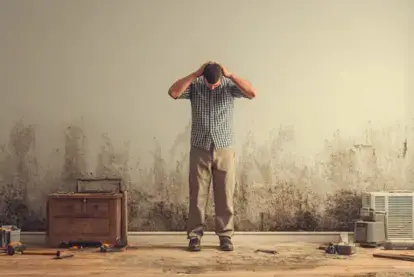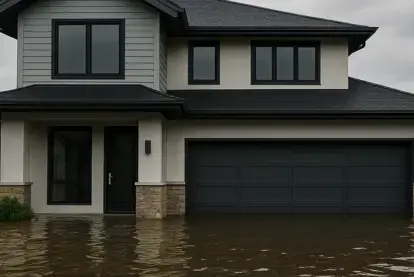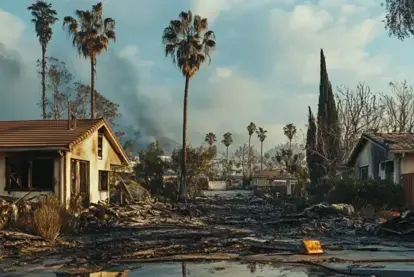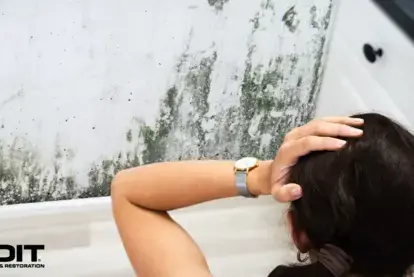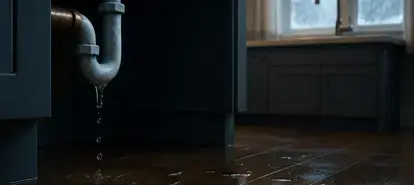
How to Handle Water Damage from Frozen Pipes
Contact COIT for a professional cleaning!
With all the cold snaps large swaths of the nation have been experiencing this winter, burst pipes have become a common nuisance for homeowners and businesses. Water pipes freezing is the leading culprit of burst water pipes that can cause so much costly damage. When temperatures dip below freezing, water inside your pipes can turn into ice and expand. This puts tremendous pressure on your water pipes, which can in turn cause them to crack and burst.
In many cases, a homeowner or business owner may not even realize their water pipes have burst until the ice has thawed and the leaking begins. You may be out for the day, then return home to find pools of water collecting on the floor and flooding from pipes left damaged after a winter freeze.
Quick Action Plan: What to Do Right Away
If you’re staring at a burst pipe or water leaking indoors, act fast to minimize damage and safety risks.
- Shut off your main water valve immediately to stop the flow.
- Turn off electricity to affected areas if there’s standing water near outlets or appliances.
- Drain faucets and flush toilets to relieve pressure.
- Mop or blot up standing water to reduce soaking into floors and walls.
- Move furniture and valuables away from wet areas.
- Document the damage with photos or video for insurance purposes.
- Call a licensed plumber and restoration professional for inspection and drying.
Mold can start forming within 24 to 48 hours, so the sooner you act, the less costly and complicated the cleanup will be.
What Causes Burst Water Pipes
While freezing temperatures are the main cause of burst pipes, other underlying factors can also contribute to pipe cracks and damage.
When rust and corrosion build up inside pipes, for instance, the pipe material can degrade and become more vulnerable to bursting. Trees located near your pipes can also send out their roots to invade pipes, leading to cracks and leaks.
Significant soil movement caused by construction, temperature changes or plumbing system repairs can damage water pipes, as can high water pressure and serious clogs that make their way deep within the system.
Why freezing is so destructive:
When water freezes, it expands by about 9%, which increases pressure inside pipes—even strong copper or PVC pipes can rupture under that strain. This pressure has nowhere to go, so the pipe bursts at its weakest point, often behind walls, under sinks, or in unheated crawl spaces.
Signs that Your Water Pipes Have Burst
If you suspect that you may be dealing with burst pipes, the first thing to do is to look for signs of water leakage and damage. Puddles will typically be larger and spread wider in the event of a burst pipe versus a leak, so look for pooling water under sinks, near pipe fittings and fixtures, and around toilets, dishwashers, and washing machines.
Another sign to look for is lower than usual water pressure, since cracks in pipes can restrict the flow of water. You may also notice stains on your walls and floors that indicate a burst pipe. If corrosion is the cause of the burst water pipe, you may also see a reddish discoloration or smell a metallic odor in the water.
In some cases, you might be able to hear signs of a burst water pipe in the walls. The sound of constant dripping, for example, could be an indication that a pipe is burst. If you notice your water bill is higher than normal, that may also be linked to a burst water pipe.
Mold and mildew can be another indicator of a burst water pipe. If the pools of water you find have a strong odor, the water leaking from the burst pipe likely has dirt or debris in it and may be contaminated — posing a potential health threat.
Regardless of whether you hear, see or smell something unusual, it’s important to take immediate action as soon as you suspect you may have a burst pipe. It doesn’t take long for a frozen pipe to do serious damage to your home or business. In the presence of standing water, it only takes 24 to 48 hours for mold and mildew to appear* — and once it does, it can lead to or worsen respiratory problems.
Water damage from burst frozen pipes can also cause wood to rot and warp, resulting in costly structural damage to property. Water from burst pipes can additionally wreak havoc on carpets, flooring, drywall, furniture and your personal belongings.
![What Do I Do If My House Floods? [8 Steps] | Coit](/sites/default/files/styles/original/public/media/2025-09/Coit-Restoration-CTA-Water-Damage.png.webp?itok=9rGQsHWC)
How to Thaw Frozen Pipes Safely
Sometimes pipes freeze but haven’t burst yet, and quick action can save them. Here’s how to thaw them safely:
- Open the faucet nearest the frozen section so melting water can flow out.
- Warm the pipe gradually using a hair dryer, heating pad, or space heater placed nearby. Move slowly along the pipe until water pressure returns.
- Never use an open flame or blowtorch, which can ignite nearby materials or damage the pipe.
- Check unheated areas first (basements, attics, crawl spaces, garages) where freezing is most common.
- If you can’t locate the frozen section or water flow doesn’t return, call a plumber immediately.
Thawing too quickly or using unsafe methods can make a frozen pipe burst, so patience and gentle heat are key.
When Water Pipes Burst, Don’t Delay
To minimize the damage as well as the health risk, here are some key steps to take as soon as your realize your pipes have burst.
- Turn off your water supply. Valves are typically located in the basement, crawl space, close to the water heater, or outside near the water meter.
- Turn off your electricity if there are signs of serious leakage, since water may find its way to your electrical sockets or fuse box.
- If you’re dealing with water pipes freezing and bursting, drain your faucets to keep them from refreezing. Flush your toilets a few times, turn off your boiler or water heater, and leave your faucets and taps open to prevent pressure from building up.
- Find the leak if you can. Check the bathroom, kitchen and basement. Look for bulges in the cleaning and floors, and for water spots on the walls. If you do fine a leak, try temporarily plugging it with rags and place a bucket if needed to catch the leaking water and minimize damage to your floors.
- Call your plumber to identify the issue, evaluate the best course of action, and make any needed repairs to your pipes and system.
- Clean excess water with a mop or rags so it’s not sitting around (if there are signs of contamination, wait for a professional to do the clean-up). Move furniture and any other belongings out of the way, open the windows to let in fresh air, and set up fans or dehumidifiers to accelerate the drying process.
- Document any damage caused by the burst pipe by taking pictures of affected items, areas and the spot where the leak started. This will come in handy in dealing with insurance and expediting claims.
- Call a restoration professional as soon as you can. Superficial cleaning with a mop or rag won’t remove all the water that has soaked into hard-to-clean places, and drying water-damaged areas requires specialized equipment.
Is Water Damage from Frozen Pipes Covered by Insurance?
In most cases, yes, most standard homeowners insurance policies cover sudden and accidental water damage caused by a burst pipe. But your damage might not be covered if it resulted from neglect, such as failing to keep your home heated during freezing weather.
To make the process smoother:
- Contact your insurance provider immediately and explain what happened.
- Take photos and videos of all affected areas before cleanup begins.
- Keep records of plumber and restoration invoices.
- Don’t throw away damaged materials until your adjuster has inspected them.
Coverage limits vary, so it’s worth reviewing your policy before winter hits to confirm what’s included.
How Much Does Cleanup and Repair Cost?
The cost of repairing water damage from frozen pipes depends on how quickly you act and how much of your home is affected.
- Minor leaks caught early may cost as little as $500–$1,000 to repair.
- Moderate flooding or wall damage can range from $2,000–$5,000.
- Major structural or mold damage may exceed $10,000, especially if drywall, flooring, or insulation must be replaced.
Drying and dehumidification usually take three to five days, but full restoration may take longer depending on materials and moisture levels.
How to Prevent Frozen Pipes in the Future
The best way to avoid costly water damage is to prevent pipes from freezing in the first place.
- Insulate exposed pipes in attics, basements, crawl spaces, and garages using foam sleeves or heat tape.
- Seal drafts and cracks around windows, doors, and foundation walls to block cold air.
- Keep your thermostat set to at least 55°F even when you’re away.
- Open cabinet doors under sinks to allow warm air to circulate.
- Let faucets drip slightly during cold snaps to relieve pressure buildup.
- Disconnect and drain outdoor hoses before winter.
- Check pipes regularly during extreme cold spells to spot freezing early.
If you plan to travel, have a friend or neighbor check your home periodically, or install a smart thermostat and leak detector that can alert you to sudden temperature drops.
Why Professional Restoration Matters
Even a small amount of water left behind after a burst pipe can lead to mold growth, rot, and structural damage. While surface cleanup might make things look dry, moisture often seeps into flooring, drywall, and insulation, which are places that standard household fans can’t reach.
Professional restoration teams use industrial-grade drying equipment, moisture meters, and HEPA dehumidifiers to ensure your home is completely dry and safe. Certified experts can also sanitize and deodorize affected areas to prevent future contamination or odor.
The Hidden Dangers of Mold and Contamination
Mold and mildew can appear within 24 hours of water exposure and quickly spread through spores in the air. These can aggravate allergies, asthma, and other respiratory conditions.
If you notice a musty smell, visible mold, or persistent dampness, it’s best to contact professionals right away. COIT’s certified specialists use safe, EPA-approved methods to eliminate mold at its source and restore healthy air quality.
Leave the Restoration to the Professionals
Calling in a specially trained, certified restoration pro is essential to restoring your property and personal items to their original condition, minimizing further damage, and ensuring your space is decontaminated to protect the health of your family or occupants.
COIT’s experienced, independently certified restoration professionals are ready to respond quickly following burst water pipes and resulting water damage. We’ll help you inspect and assess the damage, salvage and restore personal belongings, prevent mold growth with industrial-grade drying, sanitize and deodorize affected areas, and get your life back normal.
COIT’s Restoration Team is available 24/7.
If frozen pipes have burst in your home or business, schedule online or call COIT today for professional water damage cleanup and restoration before the damage spreads.
Frequently Asked Questions About Water Damage from Frozen Pipes
How do I know if my pipes are frozen or just blocked?
To tell if your pipes are frozen or just blocked, start by turning on several faucets throughout your home. If water flows normally from some taps but only drips or doesn’t come out at all from others, that’s a clear sign of a frozen section rather than a simple clog. You may also notice frost on exposed pipes or hear strange gurgling noises as ice restricts the flow.
Can I thaw frozen pipes myself?
Yes, you can thaw frozen pipes yourself if the pipe is accessible and hasn’t cracked yet. The safest way to thaw a frozen pipe is by applying gentle, consistent heat — such as using a hair dryer, heating pad, or portable space heater nearby. Never use an open flame or blowtorch to thaw frozen pipes, as this can cause the pipe to burst or start a fire. If you’re unsure where the freeze is or don’t see improvement within a few minutes, call a plumber for professional help.
How long does it take to fix water damage from a burst pipe?
Fixing water damage from a burst pipe usually starts with cleanup and drying, which can take anywhere from two to five days depending on how much water is involved. Full restoration — including repairing walls, flooring, and insulation — may take up to two weeks or longer for severe damage. The faster you start the drying process after a pipe bursts, the quicker the repairs and the lower your overall costs will be.
What should I do if my house floods while I’m away?
If your house floods while you’re away, shut off the main water supply and power to the affected area as soon as it’s safe to do so. Then contact your insurance company right away to start a claim and document the damage with photos or video. Finally, call COIT’s 24/7 emergency response team to remove standing water, dry the property, and prevent mold growth before it starts — even if you’re not home to manage the cleanup yourself.
The Bottom Line
If you’re dealing with water damage from frozen pipes, don’t wait for the problem to get worse. COIT’s certified restoration specialists are available 24/7 to remove standing water, dry and sanitize your home, and stop mold before it starts.
We’ll handle every step—from inspection to full restoration—so you can get back to normal faster.
Call COIT today or schedule an emergency service online to protect your home from lasting damage.
